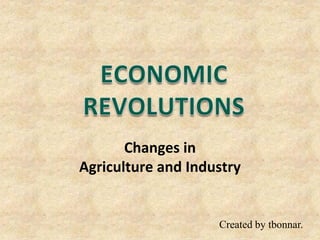
Economic Revolutions - Agricultural Revolution
- 1. Changes in Agriculture and Industry Created by tbonnar.
- 2. Job Sectors • Types of jobs in society can be classified into three main sectors: Agriculture/Resource ex. Farming, mining, forestry, fishing Industry ex. Factories, workshops, construction Service ex. Retail, teaching, banking, nursing
- 3. Economies of Nations • Nations tend to have one of these three sectors as the major type. Poor Nations - agricultural & resource (subsistence farming, mines, forestry) ex. Haiti Middle Nations - industrial (with some agricultural & resource) ex. Mexico Rich Nations - service dominated (with some agricultural & resource and industry) ex. USA
- 4. Economies of Nations • The strongest nations have a mix of all three, with most of the jobs being service. • In those countries service jobs pay better than industrial jobs, which pay better than resource jobs (for the most part). Sector Agriculture & Resource Industry Service
- 5. Progression of Nations • Nations desire to progress. Agriculture Industry Service & Resource • To do this they need to undergo agricultural and industrial revolutions. In other words, to dramatically change the way that agriculture and industry are done in their countries.
- 7. The Agricultural Revolution From: To: • Lots of farmers • Very few farmers • Most people farm • Many work in factories • Poorly used land • Better used land • Hand tools • Machines • Not much food • Plenty of food
- 8. Farming in the Middle Ages • Manual labour (basic tools) • Shared labour • Common land / Open fields • Three field system • Gleaning by the poor
- 9. 1. Bigger Farms a. Enclosures b. Land Reclamation 2. Better Equipment a. Machines 3. Better Techniques a. Crop Rotation b. Selective Breeding
- 10. 1. BIGGER FARMS a. ENCLOSURES • Enclosing land meant put hedges, fences, o r stone walls around farms to claim the land and keep people and animals out.
- 11. 1a. ENCLOSURES • Small, individually owned farms were bought or taken away from poorer farmers and turned into large enclosed farms owned by a richer farmer.
- 12. 1a. ENCLOSURES Before •Each person got some good and some bad land. •There was common land. AFTER •Each landowner received a single piece of property •No common lands
- 13. Small Farmers Were Forced off Their Land • Had to pay for : Fences/Walls to surround their farms A team of oxen • Could no longer glean or gather wood • Often had to sell plots to large landowners: Forced to Rent or Work for someone else
- 14. Map of Land Enclosed by Parliament
- 15. Example: the Highland Clearances in Scotland • Sometimes land was just taken from people because they could not prove ownership. • This increased the number of people looking for work.
- 16. Enclosures Benefited Large Land Owners • They had the political strength to pass the enclosure law • They owned large unified farms under this system which meant: Farming was more efficient Didn’t need consent of the village to experiment with new crop methods Could obtain cheap labour
- 17. 1b. LAND RECLAMATION • In addition to enclosures, farms also increased in size because of land reclamation: – Marshlands were drained – Forests were cleared – Poor soil was enriched and used more
- 18. 2. BETTER EQUIPMENT: MACHINES OF THE AGRICULTURAL REVOLUTION • Labour on farms had always been done by hand. This was harder to do now with bigger farms. • Farmers with large farms were earning more money, and now they were more interested in investing in machines
- 19. • Invented by Jethro Tull • Planted seed in neat rows • Improved germination by making furrows, dropping seed into them, and covering them • Reduced amount of seed used in planting
- 20. Examples of Additional Machines Horse-drawn cultivator – Jethro Tull
- 21. Examples of Additional Machines Cast-iron plow (1797) – American Charles Newbold
- 22. Examples of Additional Machines Reaper – Englishman Joseph Boyce (1799) and American Cyrus McCormick (1834)
- 23. 3. BETTER TECHNIQUES: a. CROP ROTATION • People Wheat learned that crops could be rotated to improve the Turnips Clover nitrogen in the soil instead of just leaving land fallow. Barley
- 24. CROP ROTATION
- 25. CROP ROTATION • Use of Clover and Turnips fixed nitrogen in the soil while also providing food for animals • Yields of Wheat and Barley proved to be better than Rye, especially with the improved nitrogen levels in the soil
- 26. 3. BETTER TECHNIQUES: b. SELECTIVE BREEDING • Farmers began the selective breeding of animals such as sheep and cattle • Produced better animals with better offspring • Produced more milk, meat, and wool
- 27. Summary: Agricultural Revolutions Need Bigger Farms • Enclosures • Land Reclamation Better Equipment • Machines Better Techniques • Crop Rotation • Selective Breeding
- 28. THE SPREAD OF THE AGRICULTURAL REVOLUTION • The Agricultural Revolution began in Britain, in the early 1700s. • It soon spread to other countries. In Northern Europe, it took place in the mid- 1700s. • In America, the A.R. took place in the second half of the 1700s.
- 29. Of the Agricultural Revolution 1. Agricultural production increased. 2. Cost of food dropped. 3. Increased production of food helped create a rapid growth of population. 4. Large farms, using machines and scientific methods, began to dominate agriculture. Farming became big business.
- 30. Of the Agricultural Revolution 5. The number of small farms began to decline. 6. The number of farmers decreased sharply. 7. Many farmers moved to the cities. 8. The population of cities increased rapidly.
